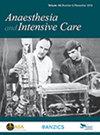Urinary chloride excretion in critical illness and acute kidney injury: a paediatric hypothesis-generating cohort study post cardiopulmonary bypass surgery.
IF 1.2
4区 医学
Q3 ANESTHESIOLOGY
引用次数: 0
Abstract
Renal chloride metabolism is currently poorly understood but may serve as both a diagnostic and a treatment approach for acute kidney injury. We investigated whether plasma chloride, ammonia and glutamine as well as urinary chloride, ammonium and glutamine concentrations may serve as markers for acute kidney injury in paediatric patients. We conducted a prospective observational trial in a tertiary care paediatric intensive care unit. Ninety-one patients after cardiopulmonary bypass surgery were enrolled. Plasma glutamine, creatinine, (serum) albumin, urinary electrolytes and glutamine were collected pre-cardiopulmonary bypass surgery, at paediatric intensive care unit admission, and at 6, 12, 24, 48 and 72 h after paediatric intensive care unit admission. The urinary strong ion difference was calculated. The median urinary chloride excretion decreased from 51 mmol/L pre-cardiopulmonary bypass to 25 mmol/L at paediatric intensive care unit admission, and increased from 24 h onwards. Patients with acute kidney injury had lower urinary chloride excretion than those without. The median urinary strong ion difference was 59 mmol/L pre-cardiopulmonary bypass, rose to 131 mmol/L at 24 h and fell to 20 mmol/L at 72 h. The plasma chloride rose from 105 mmol/L pre-cardiopulmonary bypass to a maximum of 109 mmol/L at 24 h. At 24 h the plasma chloride concentration was associated with the presence of acute kidney injury. There was no association between plasma or urinary amino acids and chloride excretion or kidney injury. In conclusion, renal chloride excretion decreased in all patients, although this decrease was more pronounced in patients with acute kidney injury. Our findings may reflect a response of the kidneys to critical illness, and acute kidney injury may make these changes more pronounced. Targeting chloride metabolism may offer treatment approaches to acute kidney injury.危重病和急性肾损伤时的尿氯排泄:心肺旁路手术后儿科假设队列研究。
目前,人们对肾脏的氯化物代谢还知之甚少,但它既可作为急性肾损伤的诊断方法,也可作为治疗方法。我们研究了血浆中的氯化物、氨和谷氨酰胺以及尿液中的氯化物、氨和谷氨酰胺浓度是否可作为儿科患者急性肾损伤的标志物。我们在一家三级医院的儿科重症监护室进行了一项前瞻性观察试验。心肺旁路手术后的 91 名患者参加了试验。我们在心肺搭桥手术前、儿科重症监护室入院时、儿科重症监护室入院后 6、12、24、48 和 72 小时采集了血浆谷氨酰胺、肌酐、(血清)白蛋白、尿电解质和谷氨酰胺。计算了尿液中强离子的差异。尿氯化物排泄量的中位数从心肺搭桥术前的 51 毫摩尔/升降至儿科重症监护室入院时的 25 毫摩尔/升,并从 24 小时后开始增加。急性肾损伤患者的尿氯化物排泄量低于非急性肾损伤患者。心肺旁路术前,尿液中强离子差值为 59 毫摩尔/升,24 小时后升至 131 毫摩尔/升,72 小时后降至 20 毫摩尔/升。血浆或尿液中的氨基酸与氯化物排泄或肾损伤之间没有关联。总之,所有患者的肾脏氯化物排泄量都有所下降,但这种下降在急性肾损伤患者中更为明显。我们的研究结果可能反映了肾脏对危重疾病的反应,而急性肾损伤可能使这些变化更加明显。针对氯化物的新陈代谢可能为急性肾损伤提供治疗方法。
本文章由计算机程序翻译,如有差异,请以英文原文为准。
求助全文
约1分钟内获得全文
求助全文
来源期刊
CiteScore
2.70
自引率
13.30%
发文量
150
审稿时长
3 months
期刊介绍:
Anaesthesia and Intensive Care is an international journal publishing timely, peer reviewed articles that have educational value and scientific merit for clinicians and researchers associated with anaesthesia, intensive care medicine, and pain medicine.

 求助内容:
求助内容: 应助结果提醒方式:
应助结果提醒方式:


